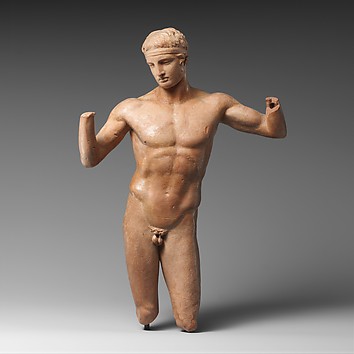 |
Portrait of Pompey the Great
Period: Late Republican
ca. 50 B.C.
Roman
Marble
|
Antiquities:
Art & Design
During the Time
of Alexander
the Great
at the Met
(continued - Issue #3)
(From the Met Museum of Art NYC Exhibition:
Pergamon and the Hellenistic Kingdoms
of the Ancient World)The Hellenistic Age that followed the conquests of Alexander the Great witnessed unprecedented cultural exchange and a burst of creative activity. The recent exhibition at the Met Museum in NYC, titled "Pergamon" gave a unique glimps into the art created during the time of Alexander the Great. Here our coverage continues. (issue #3)
 | |
|
 |
Statue of a female figure in archaistic style
Hellenistic
50–125 B.C.
Greek
Marble
|
 |
Grave Stele of an Enthroned Woman with an Attendant
Hellenistic
ca. 100 B.C.
Greek
Marble
|
 |
Applique depicting the head of Pan
Hellenistic
100 B.C.
Greek
Medium: Ivory
|
 |
Gold diadem
Hellenistic
250-150 B.C.
Greek
Medium: gold, garnet, carnelian, sardonyx
|
 |
Mosaic with street musicians
Period: Late Republican
2nd–1st century B.C.
Roman
Medium: Stone Mosaic
|
 |
Calyx Krater, so-called "Borghese Vase"
ca. 40-30 B.C.
Roman
Marble Sculpture
|
 |
Sleeping Hermaphrodite
mid 2nd century A.D.
Roman
Marble Sculpture
|
 |
Portrait of a Roman General from Tivoli
Late Republican
80–60 B.C.
Roman
Marble Sculpture
|
 |
Portrait of a man from Delos
Hellenistic
ca. 100 B.C.
Greek
Bronze
|
 |
Cameo with portrait heads
Hellenistic
278–269 B.C.
Greek, Ptolemaic
Sardonyx (gem stone)
|
 |
Rhyton with centaur protome
Hellenistic
ca. 160 B.C.
Greek
silver, gold
|
 |
Upper body of a queen
Hellenistic
175–150 B.C.
Greek
Marble Sculpture
|
 |
Statue of a triton, akroterion from the Great Altar
Hellenistic
ca. 160 B.C.
Greek
Marble Sculpture
|
 |
|
(Source: Photos by ARTSnFOOD staff and supplied by the Met Museum NYC, Any text came from the Met Museum press dept. and the wall plaques next to each work of art at the exhibition. All photos were taken with permission.)
FOOD:
Fresh Salmon
Croquettes
If you ever have some left over poached salmon,
it's a great opportunity to make salmon croquettes.
Ingredients:
To 6 oz. of cold poached salmon (shredded / no skin)
add very thin sliced + some diced onion
1 Tbs mayo
1/2 tsp creamy horseradish sauce
black pepper & salt
1/2 tsp Old Bay
pinch dried dill
dash dried roasted garlic
chopped chive greens
bread crumbs
dash of half & half
Instructions:
Mix all until it forms a nice firm texture, not to mushy
Form patties
Dip patties in bread crumbs
sauté in olive oil
From start of prep to finished cooking was 15 to 20 minutes.
These croquettes were very light in texture / held together fairly well, but were not very firm. An egg may have helped hold the croquettes together, but I would do it exactly this way.
These salmon croquettes were delicious,
served with salad greens & cucumber.
Mmmmm! Very tasty!
Until later,
Jack
ARTS&FOOD is an online magazine dedicated to providing artists and collectors around the world with highlights of current art exhibitions, and to encourage all readers to invest in and participate in “The Joy of Art” and Culture. All Rights Reserved. All concepts, original art, text & photography, which are not otherwise credited, are copyright 2016 © Jack A. Atkinson, under all international, intellectual property and copyright laws. All gallery events', museum exhibitions', art fairs' or art festivals' photographs were taken with permission or provided by the event or gallery. All physical artworks are the intellectual property of the individual artists and © (copyright) individual artists, fabricators, respective owners or assignees.
Trademark Copyright Notice: ©ARTSnFOOD.blogspot,com, ©ARTSnFOOD,
©ARTS&FOOD, ©ARTSnFOOD.com, ©ARTSandFOOD.com, ©ART&FOOD, ©ARTandFOOD.com, ©ARTnFOOD.com)








